Let's talk Beagles
Official name: Beagle
Other names: Hound, English Beagle
Origins: United Kingdom
Drooling tendencies
2 out of 5Grooming needs
1 out of 5Shedding Level
3 out of 5Barking tendencies
5 out of 5Energy level*
5 out of 5Compatibility with other pets
4 out of 5Warm weather?
3 out of 5Cold weather?
1 out of 5Suited to apartment living
3 out of 5Can stay alone
1 out of 5Family pet?*
4 out of 5
| Male | Female |
|---|---|
| 33 - 38 cm | 30.5 - 33 cm |
| 9 - 13 kg | 9 - 10 kg |
| Life Stage | |
|---|---|
| Puppy | Adult |
| 2 to 12 months | 12 months to 7 years |
| Mature | Senior |
| 7 to 10 years | 10 to 20 years |
| Baby | |
| Birth to 2 months | |
Drooling tendencies
2 out of 5Grooming needs
1 out of 5Shedding Level
3 out of 5Barking tendencies
5 out of 5Energy level*
5 out of 5Compatibility with other pets
4 out of 5Warm weather?
3 out of 5Cold weather?
1 out of 5Suited to apartment living
3 out of 5Can stay alone
1 out of 5Family pet?*
4 out of 5
| Male | Female |
|---|---|
| 33 - 38 cm | 30.5 - 33 cm |
| 9 - 13 kg | 9 - 10 kg |
| Life Stage | |
|---|---|
| Puppy | Adult |
| 2 to 12 months | 12 months to 7 years |
| Mature | Senior |
| 7 to 10 years | 10 to 20 years |
| Baby | |
| Birth to 2 months | |
Tailored nutrition for your Beagle
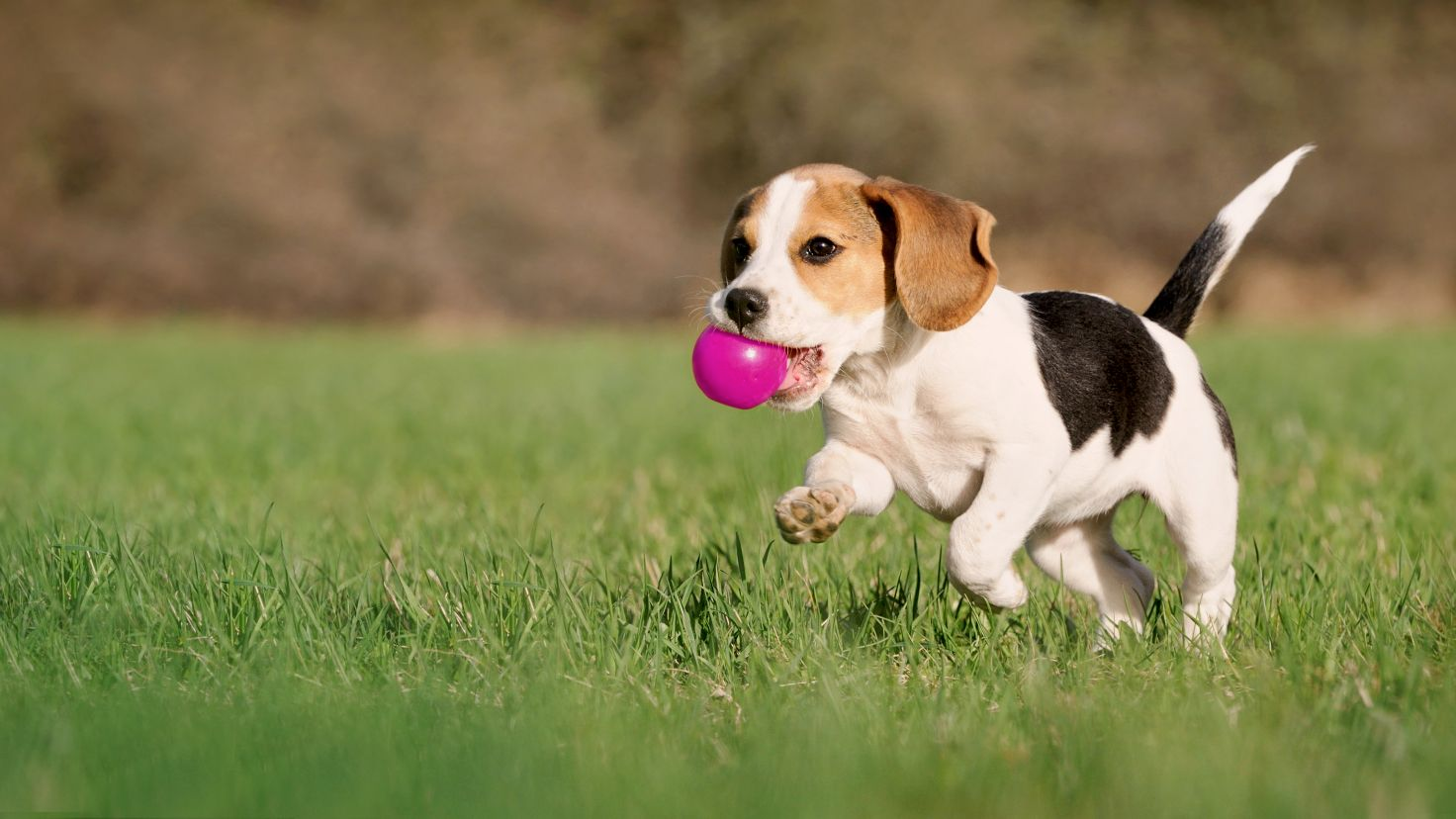
Get to know the Beagles
All you need to know about the breed
With their hangdog expression, droopy ears and expressive eyes, it’s no wonder that Beagles are one of the best-loved dog breeds around. Gentle and easy-going, they also have a lovely temperament – and, with a bit of training, Beagles are great with children and other animals too.
Although the origins of the Beagle are not precisely known, they are thought to have been with us for many hundreds of years. Believed to descend originally from the hunting hounds of the Romans, they became popular in Britain during the 1800’s. In 1890, The Beagle Club was established and the standard followed soon after.
Today, the Beagle is one of the top 10 most popular dogs in the world, according to the American Kennel Club. Also a regular fixture on our screens, they’ve had a starring role in everything from the claymation series Wallace and Gromit and hit TV show The Wonder Years to children’s movie Shiloh. Notably, there was also Snoopy, the most famous Beagle of all, who appeared in the comic strip Peanuts.
With their russet, black and white coat, the Beagle is similar in appearance to the Foxhound – though the latter is much larger. Also, within the Beagle breed itself, there are two different varieties. The American Kennel Club makes the distinction between those under 13 inches at the shoulder and those between 13 and 15 inches – though in the UK they can be slightly larger.
Active and energetic, Beagles will require at least an hour of exercise every day, but ideally more. Bred to hunt in packs, they also do better with company and are not good at being left alone.
One other word of warning before choosing a Beagle: they like the sound of their own voice and can be known to bark and bay quite frequently. They also tend to be a little more challenging to train than some breeds, but nothing that can’t be overcome with a few treats and a bit of patience.
Overall, these faithful animals make a marvellous companion. In fact, with a bit of effort invested, you’ll soon be rewarded with a new best friend.
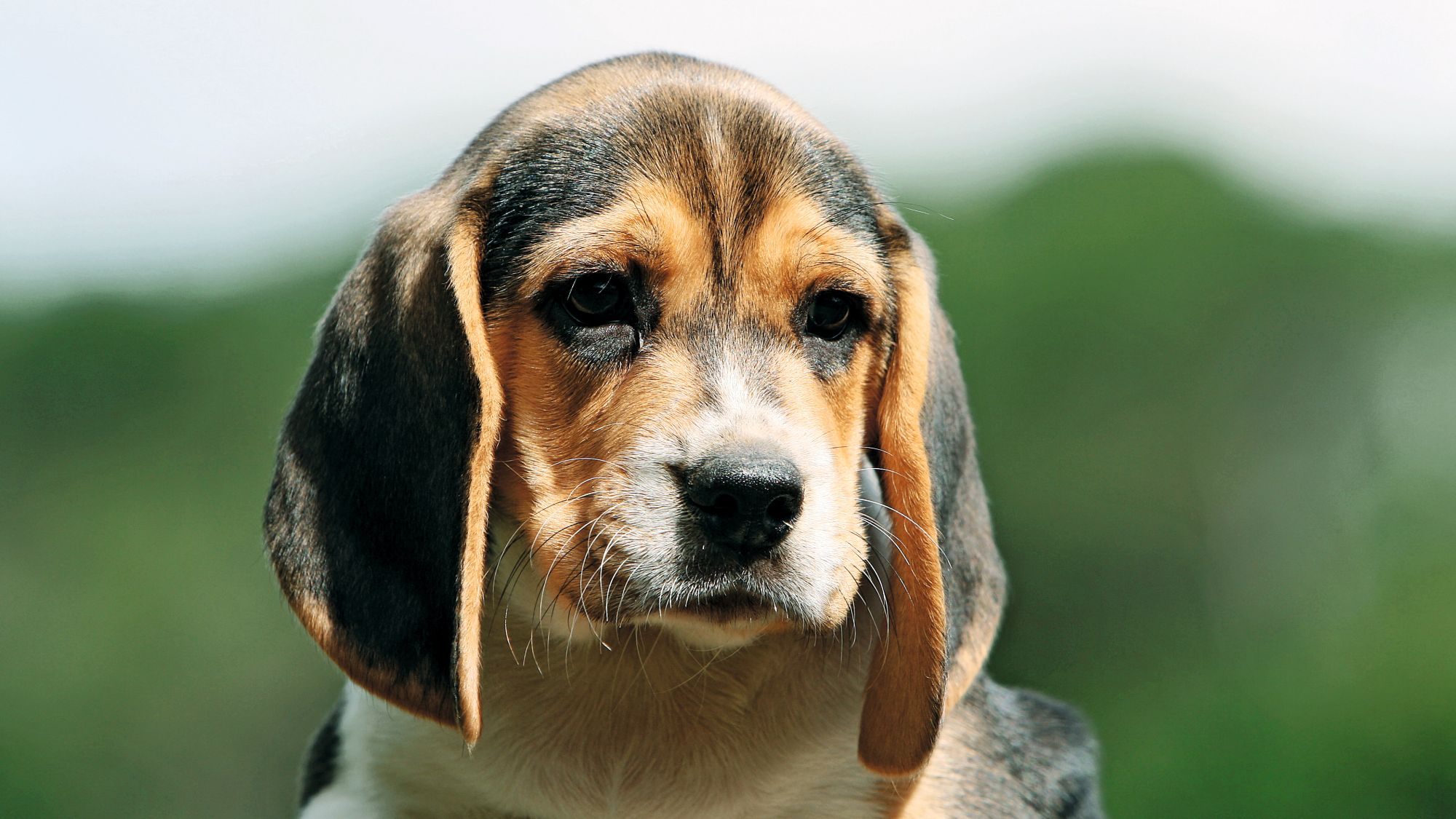
2 facts about Beagles
2. All in a day’s work
Given their excellent sense of smell, it’s no surprise that many Beagles go on to work as detection dogs at airports. Normally they are used to sniff out explosives and narcotics, but, more recently, they have also been trained to detect the presence of Coronavirus.
1. On the scent
Along with the Bloodhound and the Basset Hound, the Beagle has one of the best-developed senses of smell of any dog breed. In fact, they have some 220 million scent receptors in their nose.
History of the breed
Despite much conjecture among dog-lovers, the origins of the Beagle remain somewhat shrouded in mystery. In all likelihood, though, they probably descended from Roman hunting dogs who were used to catch rabbits and the like. Latterly, they have popped up in paintings and literature ever since Elizabethan times.
Back then, there were smaller, wire-haired Beagles – some of which were so small they could be carried in the pocket of a hunting jacket. The Beagle size has increased over the years but smaller versions of the breed, known as ‘Pocket Beagles’, still exist today.
While the exact origins of the Beagle name are lost in time, many believe the word derives from the Gaelic term ‘beag’ (little). Others suggest it comes from the French term for the blast of hunting horns (‘be’geule’).
In any event, the modern breed of Beagle is thought to have emerged in Great Britain around the 1830’s. Believed to be a cross between several breeds – including possibly the Talbot Hound, the North Country Beagle and the Southern Hound – the Beagle personality seems to combine the best features in one.
In 1890, The Beagle Club was founded in the UK and the breed standard followed soon after. Today, the Beagle appears regularly in lists of favourite breeds all over the world.
Given the Beagle’s good behavioural characteristics, their size and docile temperament, they are also the favoured breed for laboratories. Luckily, many charities work on offering them a home. Thinking of getting a Beagle? Why not turn a lab dog into a lap dog?
From head to tail
Physical characteristics of Beagles
1.Head
2.Face
3.Fur
4.Body
5.Tail
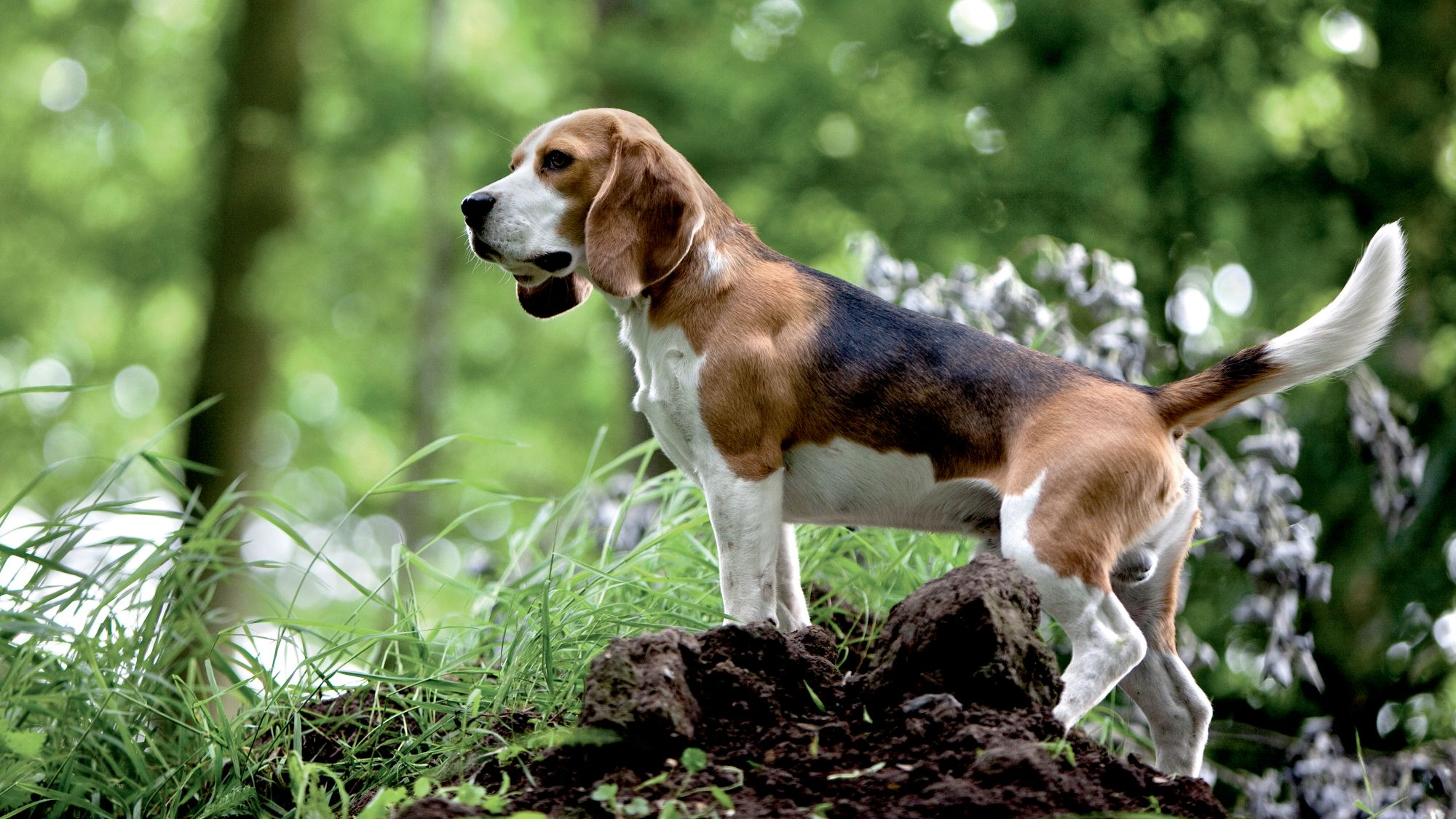
Things to look out for
From specific breed traits to a general health overview, here are some interesting facts about your Beagle
It’s important to choose an approved breeder
While the Beagle usually tends to have a pretty good lifespan, with an average life expectancy of 12 to 15 years, they can be prone to some genetic health conditions along the way – like all breeds of dog. As always, the key is to buy from a responsible and reputable breeder, as they will be screening for most inherited conditions, which will help to reduce the risks. Also, knowing if your Beagle is a carrier, or could potentially develop a health issue later on, can help you and your vet plan accordingly for their lifelong care.
Watch out for eye problems
The Beagle dog breed can also be prone to a few optical issues such as glaucoma, the degenerative disorder known as progressive retinal atrophy (PRA) and a condition called ‘cherry eye’ in which a gland starts to protrude in the corner. As so often with these things, early detection can make all the difference. With that in mind, it is important to check your Beagle’s eyes regularly and to consult your vet if there are any unusual symptoms or signs of discomfort. In addition, a comprehensive ophthalmic examination is recommended for your Beagle twice a year.
This a breed that can also be susceptible to epilepsy
Triggered by abnormal electrical activity in the brain, this neurological condition can result in mild or sometimes severe seizures. Other symptoms may show themselves as staggering, falling over or temporary disorientation. One of the more common conditions seen in Beagles, the episodes can start to occur from around six months old. While seizures can be worrying to witness, they look a lot worse than they really are. In fact, the long-term prognosis for dogs suffering from epilepsy is usually quite positive. As always, it’s best to discuss things with your vet who will be able to recommend a suitable course of medication for your Beagle.
Healthy diet, healthier dog
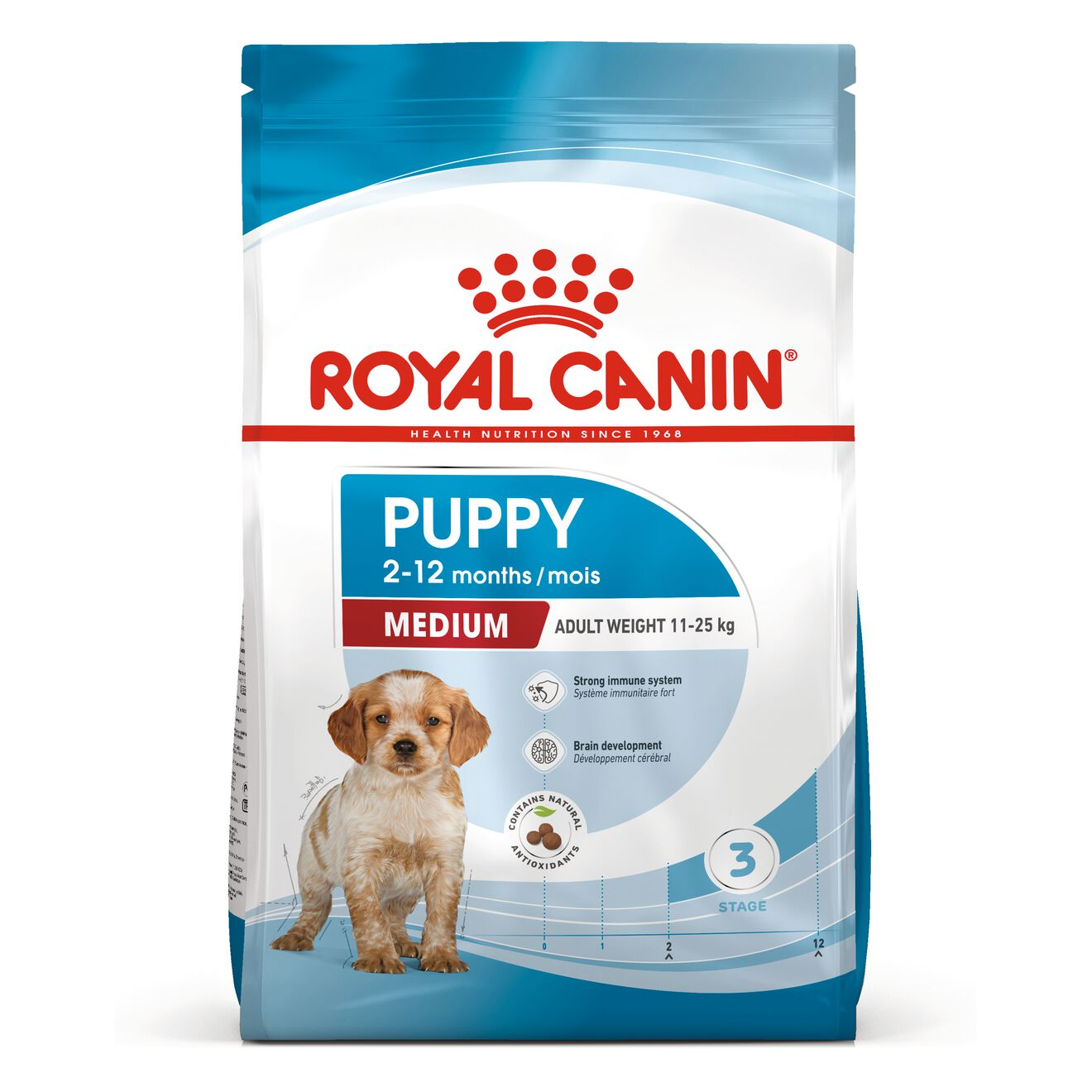
When choosing food for a Beagle, there are many factors to consider: their age, lifestyle, activity level, physical condition, and health including potential sickness or sensitivities. Food provides energy to cover a dog’s vital functions, and a complete nutritional formula should contain an adjusted balance of nutrients to avoid any deficiency or excess in their diet, both of which could have adverse effects on the dog. Clean and fresh water should be available at all times. In hot weather and especially when out exercising, bring water along for your dog’s frequent water breaks. Energy intake will always have to be adapted to the climatic conditions. A dog that lives outdoors in winter will have increased energy requirements.
The following recommendations are for healthy animals. If your dog has health problems, please consult your veterinarian who will prescribe an exclusive veterinary diet. A Beagle puppy’s requirements, in terms of energy, protein, minerals, and vitamins, are much greater than those of an adult dog. They need energy and nutrients to maintain their body, but also to grow and build it. Until they are 12 months old, a Beagle puppies’ immune system develops gradually. A complex of antioxidants - including vitamin E - can help support their natural defences during this time of big changes, discoveries, and new encounters. Their digestive functions are different from an adult Beagle, too: their digestive system is not mature yet so it’s important to provide highly digestible proteins that will be effectively used. Prebiotics, such as fructo-oligosaccharides, support digestive health by helping balance the intestinal flora, resulting in good stool quality.
Similarly, a puppy’s teeth – starting with the milk teeth, or first teeth, then the permanent teeth – are an important factor that needs to be taken into account when choosing the size, shape, and texture of kibble. Calorie intake should be controlled as Beagles are known for their tendency to put on weight. It is recommended to split the daily allowance in three meals until they are six months old, then to switch to two meals per day.

The main nutritional goals for adult Beagles are:
Maintaining an ideal body weight by using highly digestible ingredients and keeping the fat content at a sensible level
Supporting healthy bones and joints with chondroitin, glucosamine, and EPA-DHA.
Promoting optimal digestibility with high quality protein and a balanced supply of dietary fibre.
Helping to preserve the health and beauty of the skin and coat with the enriched addition of essential fatty acids (especially EPA-DHA), essential amino acids, and B vitamins.
To help support their natural defences, a formula enriched with an antioxidant complex and containing mannan-oligosaccharides is recommended.

After 7 years old, Beagles start facing the first signs of ageing. A formula enriched with antioxidants will help maintain their vitality, and specific nutrients, such as chondroitin and glucosamine, will help maintain healthy bones and joints. Ageing is also accompanied by the modification of digestive capacities and particular nutritional requirements, so food for older Beagles should have the following characteristics:
Higher vitamin C and E content. These nutrients have antioxidant properties, helping to protect the body’s cells against the harmful effects of the oxidative stress linked to ageing.
High-quality protein. Contrary to a widely held misconception, lowering the protein content in food brings little benefit in limiting kidney failure. In addition, older dogs are less efficient at using dietary protein than younger dogs. Reducing the phosphorous content is a good way of slowing down the gradual deterioration of kidney function.
A higher proportion of the trace elements iron, zinc, and manganese to help maintain the good condition of the skin and coat
A higher quantity of polyunsaturated fatty acids (borage oil, fish oil) to maintain the quality of the coat. Dogs normally produce these fatty acids, but ageing can affect this physiological process.
As they age, dogs increasingly suffer from teeth problems. To ensure they continue to eat in sufficient quantities, the shape, size, and hardness of their kibble needs to be tailored to their jaw.
Throughout their life, it is important to avoid feeding Beagles human foods or fatty snacks. Instead, reward them with kibble taken from their meal allowance, and strictly follow the feeding guidelines written on the package in order to prevent excessive weight gain.
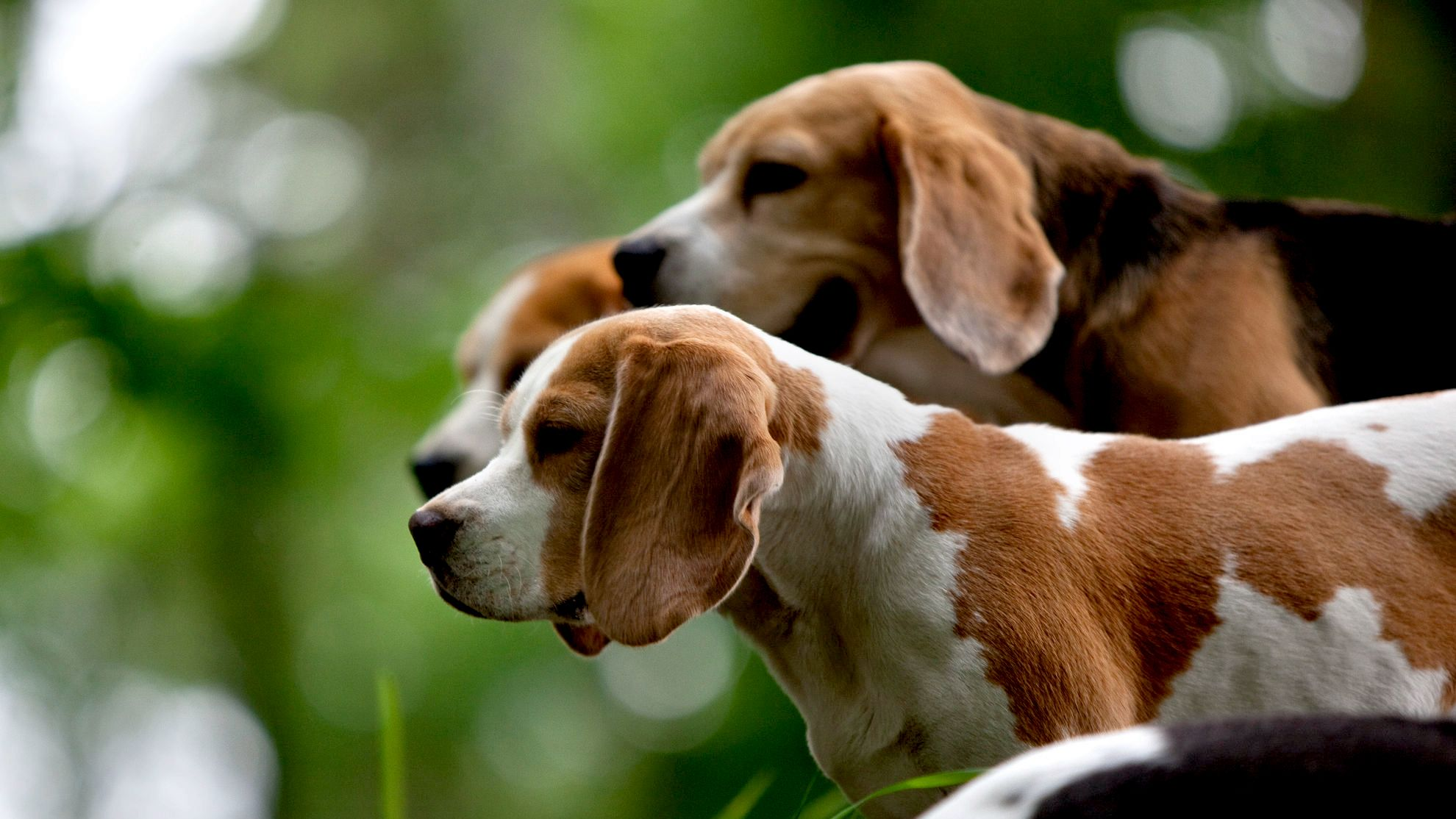
Caring for your Beagle
Grooming, training and exercise tips
Beagles tend to be athletic and energetic dogs who like nothing better than having a good sniff around outdoors. They should therefore have at least an hour of exercise every day – and ideally two or more. The older Beagle adult can become a bit lazy, and content to snuggle up in their basket, but as this is a breed that’s prone to obesity it’s important not to let that happen. Whatever age they are, Beagles still retain that inherent hunting instinct, with a tendency to chase a scent, so you may wish to keep them on the lead – or at least within eyeshot. Also, as they are consummate escape artists, with a knack for digging under fences, it’s important to keep a careful watch on them even at home in the garden.
One of the many positives of having a Beagle is the low maintenance required for their grooming. Although they have a dense double coat, which protects them from the elements, their short, smooth and waterproof fur is easy to clean and maintain. Brushing your Beagle once a week with a medium-bristle brush should be enough to remove any dead hair. Also, moulting is only moderate to average, though will be heavier during the Beagle’s shedding seasons. Because of their short fur, the occasional bath should more than suffice. Also, nails should be clipped regularly, teeth brushed as often as possible and the Beagle’s long ‘drop’ ears checked carefully during grooming.
When it comes to training your Beagle, it’s true that they can be a little more challenging than some breeds. Don’t let them know we told you. And, although they are gentle and devoted dogs, they have an independent streak too. Due to their history as hunters, Beagles will want to smell everything on their walks – and they can take longer than average to housetrain. But, on the flipside, Beagles also learn very quickly and will respond well to reward-based training – especially if it involves food. The key is to start your Beagle early with puppy-training classes and regular socialisation. With a little planning and patience, you’ll both reap the rewards.
Beagles tend to be athletic and energetic dogs who like nothing better than having a good sniff around outdoors. They should therefore have at least an hour of exercise every day – and ideally two or more. The older Beagle adult can become a bit lazy, and content to snuggle up in their basket, but as this is a breed that’s prone to obesity it’s important not to let that happen. Whatever age they are, Beagles still retain that inherent hunting instinct, with a tendency to chase a scent, so you may wish to keep them on the lead – or at least within eyeshot. Also, as they are consummate escape artists, with a knack for digging under fences, it’s important to keep a careful watch on them even at home in the garden.
One of the many positives of having a Beagle is the low maintenance required for their grooming. Although they have a dense double coat, which protects them from the elements, their short, smooth and waterproof fur is easy to clean and maintain. Brushing your Beagle once a week with a medium-bristle brush should be enough to remove any dead hair. Also, moulting is only moderate to average, though will be heavier during the Beagle’s shedding seasons. Because of their short fur, the occasional bath should more than suffice. Also, nails should be clipped regularly, teeth brushed as often as possible and the Beagle’s long ‘drop’ ears checked carefully during grooming.
When it comes to training your Beagle, it’s true that they can be a little more challenging than some breeds. Don’t let them know we told you. And, although they are gentle and devoted dogs, they have an independent streak too. Due to their history as hunters, Beagles will want to smell everything on their walks – and they can take longer than average to housetrain. But, on the flipside, Beagles also learn very quickly and will respond well to reward-based training – especially if it involves food. The key is to start your Beagle early with puppy-training classes and regular socialisation. With a little planning and patience, you’ll both reap the rewards.
7/7
All about Beagles
On average, a fully-grown Beagle dog will reach no more than around 15 to 16 inches (38-40.5cm) and the top weight for a Beagle is 30lb (13.5kg). Because of their relatively compact size, Beagles will adapt well to life in most styles of home. The American Kennel Club recognises two Beagle types: those standing under 13 inches at the shoulder, and those between 13 and 15 inches, and weights vary accordingly.
Your Beagle will need at least an hour of exercise every day, but ideally two hours or more. If you fall in the “but I exercised last week!” category, this might not be the breed for you. A combination of walking, running and play work well. They will also benefit from time spent outdoors sniffing around in the garden.
Other breeds that might interest you
Read more on this topic
Sources
- Veterinary Centers of America https://vcahospitals.com/
- Royal Canin Dog Encyclopaedia. Ed 2010 and 2020
- Banfield Pet Hospital https://www.banfield.com/
- Royal Canin BHN Product Book
- American Kennel Club https://www.akc.org/
Like & share this page